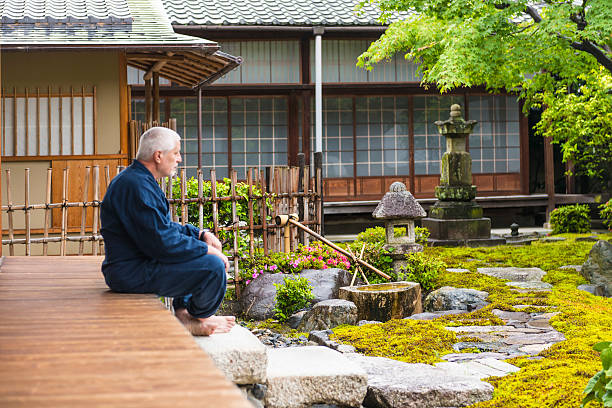Welcome to the serene world of Zen gardens, where tranquility and simplicity reign supreme. The introduction of a Zen garden brings a sense of peace and harmony to any space, inviting contemplation and mindfulness. These meticulously crafted gardens, often consisting of carefully arranged rocks, sand, and plants, serve as a reflection of nature’s beauty. The artistry behind a Zen garden lies in its ability to evoke a sense of calm and balance in those who experience it. By incorporating elements of Zen philosophy and design principles, these gardens offer a sanctuary for reflection and inner peace.
Here are 15 most beautiful Zen gardens in Japan
1) Ryōan-ji (Kyoto)

Nanzen-ji (Kyoto)
It is the most famous iconic Zen garden of Japan, in which 15 big stones were set in unique pattern in white marble. White gravel symbolize flow of water. Interesting thing is that you can see all the stone from all angle, one stone hide between 14 stone which represent incomplete knowledge and enlightenment of Zen philosophy.
2) Saihō-ji (Kyoto)
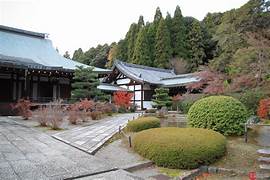
This temple is world famous of its lush green moss garden and it is included in UNESCO World Heritage Site. tourists can found more than 120 varieties of moss which cover whole ground in natural carpet. Central pond of this garden is designed in heart shape, who surrounded by moss and trees, make divine atmosphere. Tourists need special permission and reservation to visit in this temple.
3. Tenryū-ji
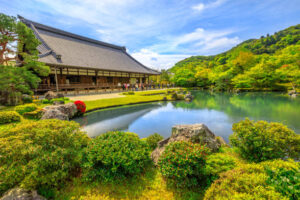
This garden is made in 14th century and it is the perfect example of borrowed scenery. Here’s Sōgenchi pond reflect mountain and sky, which feel like a moving painting. In autumn and spring season, beauty of this garden at its peak. It is also included in UNESCO World Heritage Site and also it is most visited Zen Garden in Kyoto.
4. Daisen-in

Garden of Daisen-in shows the symbolic of life journey. White gravel designed like a floating river which flows from the mountains and reaches to the sea. It is a representation of Rock Waterfall and island. It is a small garden but it give deep philosophical message that life is a flow which reaches at its end.
5. Ryōgen-in (Kyoto)

It is a small but peaceful garden of Daitoku-ji complex. Here moss and carefully placed stones make a landscape symbolic. Here is also a small element, very small dry garden of Japan “Totekiko”, which symbolize space with some rock and same
6. Taizō-in
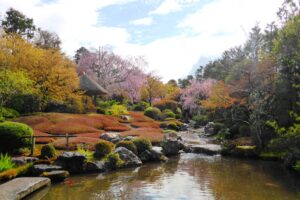
It is established in 1404 and it is the oldest sub-temple of Daitoku-ji. Here’s Motonobu no Niwa is a dry landscape garden which is symbolic of flowing water and ocean, Their is also a pond garden with shows own charm. It is a perfect combination of Artistic design aur Zen simplicity.
7. Tenju-an (Kyoto)
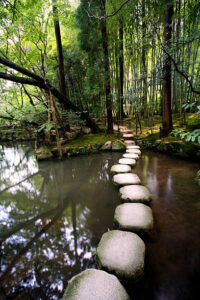
This garden is famous for stone pavement and beautiful autumn scenery. Reflection of evening light make a magical feel. Its rock arrangements and pond feel very soothing.
8. Nanzen-ji (Kyoto)
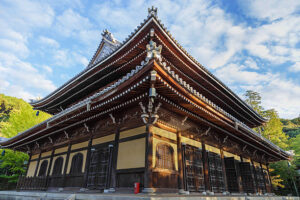
it is one of the largest Zen garden in Kyoto , Highlight of Nanzen-ji is “Leaping Tiger Garden”. In this garden, stones are arranged in that way, like a tiger leap on the water. In autumn season, beauty of this garden become more beautiful.
9. Banryūtei (Kongobu-ji, Mt. Koya)
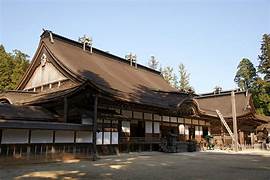
It is the largest garden in Japan which is spread in 2340 square meters. It symbolize dragon fly on the clouds, which is arranged by 140 granite stones. T this temple visitor can listen to the semons of the monks and participate in ajikan meditation sessions.
10. Zuisen-ji (Kamakura)

This garden is designed by Musō Soseki and it is a mixture of dry landscape and hillside backdrop. Here stone arrangements and natural setting make a poetic harmony. This garden is quiet retreat between the greenery of Kamakura. The beauty of this garden is at its peak in both spring and autumn season.
11. Kennin-ji (Kyoto)
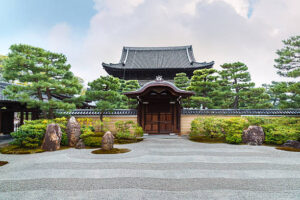
It is the oldest Zen Temple which was established in 1202 and it is famous for dry rock and moss gardens. Here you will find different courtyard with symbolic design that show simplicity and calmness. Apart from the garden, the temple’s Twin Dragons ceiling painting is a big attraction. It’s a place where you can experience both meditation and art together.
12. Jisso-in (Kyoto)

Jisso-in is famous for its “reflection floor,” where the polished wooden surface shows a clear mirror image of the garden and autumn leaves. It feels almost like a natural painting. Every season brings a new charm, making the view fresh and different each time.
12. Jisso-in (Kyoto)
Jisso-in is famous for its “reflection floor,” where the polished wooden surface shows a clear mirror image of the garden and autumn leaves. It feels almost like a natural painting. Every season brings a new charm, making the view fresh and different each time.
14. Ginkaku-ji (Kyoto) – Silver Pavilion

Ginkaku-ji is well known for its cone-shaped sand mound called Kogetsudai and its neatly raked white gravel. The gravel is said to represent sea waves, while the cone is like a platform for moon-viewing. Together with the pavilion and trees around, the garden looks magical in every season.
15. Tōfuku-ji (Kyoto)

Tōfuku-ji is popular for its dry rock gardens and beautiful autumn colors. From the wooden bridges, you can see the maple forest and gardens below in a breathtaking way. The balance of rocks and moss gives a true Zen feeling that attracts many visitors.
History of Zen garden
The history of Zen Garden is deeply connected with Zen Buddhist. This garden is made in Kamakura period (12-14 century), It is design for monks do meditation, reflection and inner peace. Zen Garden also known as Karesansui or dry landscape garden. Use of plant and water are vey less in this garden, but white gravel and sand are used to symbolize water, and big stones represent the mountains/Island
The pattern drawn by wooden rack on the sand is not only for design but it calm our mind and symbolize the flow of nature. These gardens mostly built under the temple complexes, where monks do mindfulness and meditation practices. Every elements of the garden have symbolic meaning like harmony, balance and simplicity, which is the part of Zen philosophy.
Today, these gardens are the important part of Japanese culture and it is worldwide famous. People use Zen garden not only in temple, but also use in Office, home, and public spaces for stress relief, meditation and peaceful atmosphere.

